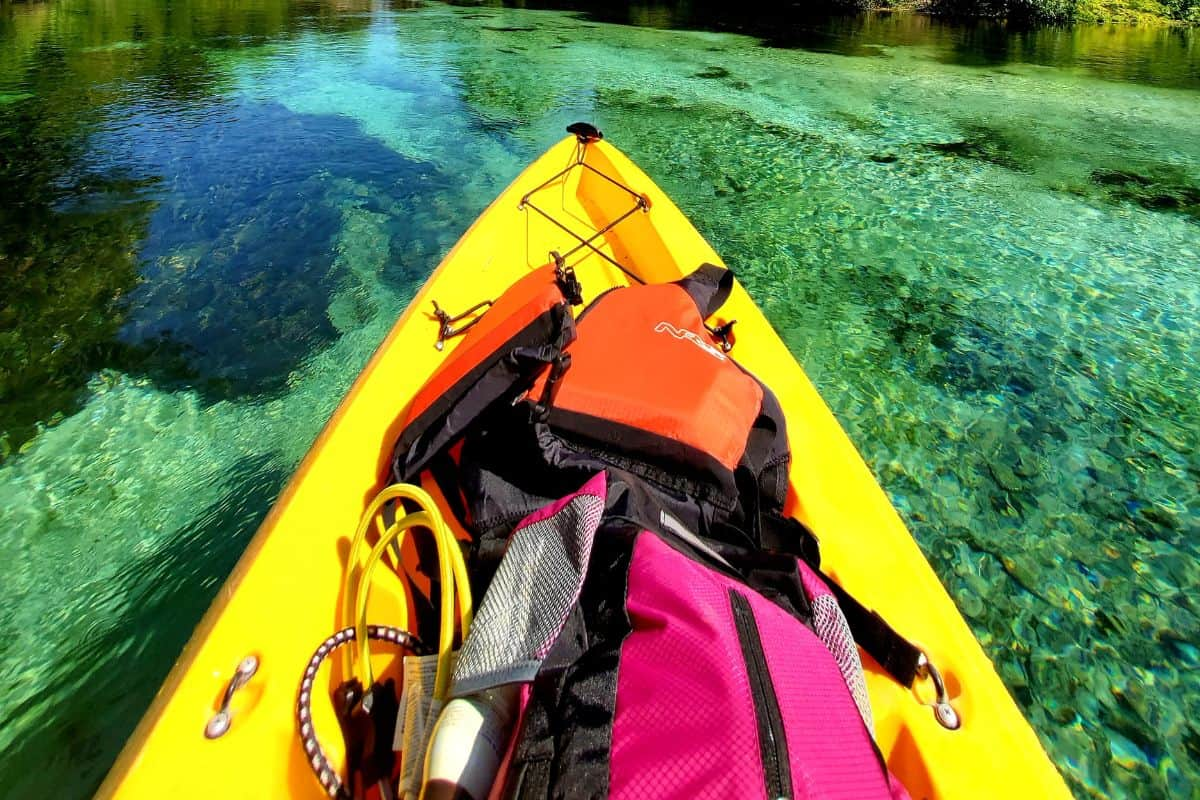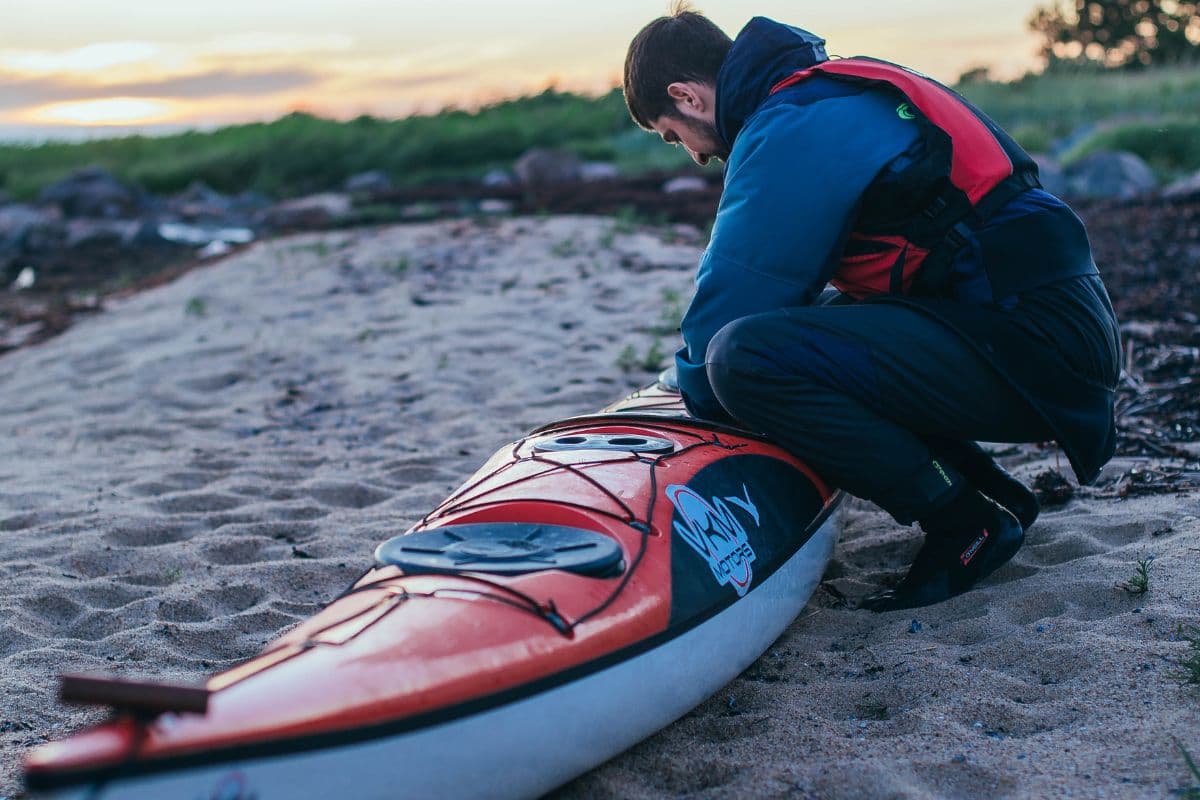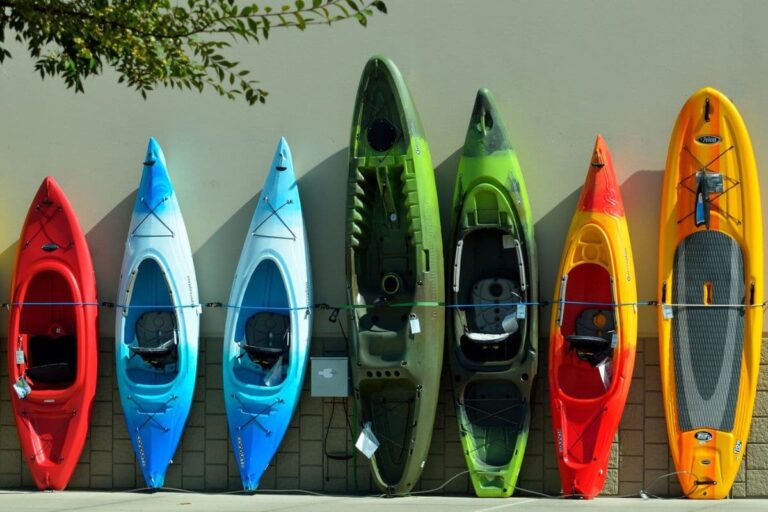How To Increase A Kayak’s Weight Capacity? (6 Tips)
So you got yourself a new kayak, and you’ve noted the manufacturer’s stated weight limit.
If you’re wondering how to increase your kayak’s weight capacity, there are several options and factors to consider.
In order to increase the weight capacity of your boat, we will discuss an array of options, from least to highest amount of maintenance. These include choosing the appropriate body of water, using proper paddling techniques to help you maneuver a heavier boat, installing float bags or stabilizers, and modifying the actual structure and design of your kayak.
Why Is A Kayak’s Weight Capacity Important?

Before you start using your boat, make sure you’re knowledgeable about how the kayak’s weight capacity will affect your kayak usage.
To begin with, most kayaks are made up of a fairly light frame, a waterproof cover, and a hole in the top where the kayaker sits.
A kayak’s lightweight construction is what allows it to stay afloat on the water.
As you might expect, adding too much weight to a kayak can cause it to sink.
Most recreational kayaks advertise a weight limit of 250-300 pounds, which is significantly higher than the average adult male’s weight in the United States.
The manufacturer’s weight limit is a flexible value, and even if you go 5-10 pounds over the quoted limit, your kayak will not automatically sink.
Even so, raising the overall weight capacity of your kayak can provide you with added peace of mind.
It might even give you the opportunity to bring some extra items along!
Now that you have a basic understanding of how a kayak’s weight limit works, let’s look at a few standard methods for increasing your kayak’s weight capacity.
6 Ways to Increase Weight Capacity
1. Choose The Right Location
When it comes to kayaking, selecting the right area for your trip will play a critical role in your overall experience.
As you may expect, kayaking on choppy or unstable waters is not a good idea if you’re trying to push the weight capacity of your boat.
When you paddle through turbulent waters, water splashes into your cockpit and builds up, slowly but surely.
And if you’re nearing or over your boat’s maximum weight capacity, this effect will intensify, bringing you down even faster.
On the other hand, opting to paddling in stable and smooth waters will increase the likelihood that you’ll enjoy your trip, even with a potentially overloaded kayak.
This is because the amount of water splashing into the kayak’s cockpit will be much less, thereby decreasing the chance that your boat will be overpowered by the waves.
This is why choosing the right location is the simplest way to boost your kayak’s weight capacity or, at the very least, mitigate the effects of overloading your boat.
2. Learn How To Paddle Correctly

Whether you consider kayaking a sport or just a recreational activity, learning and maintaining excellent paddling form and technique can improve your experience.
Proper form and technique are an excellent way to minimize fatigue, which enables you to spend long periods of time doing what you love.
If you don’t use the correct technique, an overweight kayak will become even more challenging to maneuver.
Even with a packed kayak, staying active and maintaining good form in your paddle strokes will boost your chances of staying afloat.
Paddling in a uniform, balanced manner will also reduce the amount of water that is splashed into your boat by the paddle.
While your kayak’s capacity won’t literally increase, you will be able to kayak safely carrying a higher amount of weight because you’re reducing the amount of water weight you’ll have to account for.
3. Float Bags
A sure-fire way to increase your kayak’s weight capacity is by using float bags.
These fit into some of your kayak’s compartments, increasing its buoyancy and helping you exceed the manufacturer’s stated weight limit.
The only drawbacks of using float bags are the extra costs associated with purchasing additional equipment for your kayak, and the fact that this installation will take up some of the valuable space in your kayak.
If you depend heavily on cargo space and already have a small-size kayak, this method may not be ideal for you.
With that said, the float bag will directly raise the weight capacity of your kayak.
This higher weight range will allow you to bring more gear, but remember they will also use up some of the gear’s storage space as well.
4. Stabilizers
Kayak stabilizers, sometimes called “float foams”, are an effective way to keep your kayak stable, even if it’s overloaded.
Stabilizers are a pair of airbags that attach to the sides of your kayak and offer an extra lift.
They won’t take up any space inside the kayak, which allows you to overload your storage well beyond the weight limit.
Many who enjoy kayak fishing will use stabilizers to add more buoyancy without sacrificing storage space.
While these airbags can be a great solution for inadequate kayak weight capacities, be prepared for the extra cost that comes with this purchase.
Some DIYers have experimented with attaching pool noodles (the kind you use in a swimming pool) to the sides of their kayaks to increase the weight capacity.
While this has worked for some, kayak manufacturers don’t recommend this as a fool-proof method.
The noodles don’t add as much buoyancy as commercial stabilizers that are designed for this purpose – plus, they’re likely to disintegrate quickly in salty water.
If you plan to use your kayak frequently in salt water, we recommend skipping the pool noodles and investing in proper stabilizers to increase the weight capacity of your kayak.
5. Structure Modification
All kayaks have a predefined structure and design, specific to each kayak manufacturer.
This kayak design is almost always crucial to the kayak’s performance, as well as the integrity of the vessel and the safety of the kayaker.
If you are experienced with power tools and don’t mind getting your hands dirty, you can try to cut out the unnecessary structural components in the kayak’s hull.
This type of modification will eliminate some extra weight, thus allowing you to carry a heavier load.
If you’re desperate for extra carrying capacity, tampering with the kayak’s design and structure should be a last resort.
If you enjoy using your kayak in rough waters, messing with the structural integrity of your boat can be detrimental.
If you’re not comfortable performing your own DIY hull design, consider upgrading to a newer kayak built with the capacity to carry heavier weights.
6. Loading Your Kayak

Okay, so this one isn’t exactly a method of increasing your kayak’s weight limit, but it is one little step you can take before you go paddling to ensure that you don’t put yourself or your belongings in danger.
Measuring the weight of your gear beforehand is the best way to stay safe while kayaking.
Just put all of your gear in a duffel bag, and weigh it using a hanging scale.
After that, add your clothed body weight, and you will have your total weight.
A recommended practice is to keep your combined weight below 70% of the manufacturer’s advertised maximum capacity – this allows for any water that will no doubt splash into your kayak.
Generally speaking, you never want to load your boat up with the maximum amount of weight it can possibly hold.
The amount of weight your boat can carry in an emergency is not the same as the amount it can carry and still function properly.
Choose the right kayak for your needs by purchasing one with a weight capacity that is well above the weight you actually plan to put in the kayak.
More About Kayak Weight Limits
Almost all the time, a kayak’s weight limit is a good amount lower than the actual sinking weight of the vessel – but that doesn’t mean the weight limit serves no purpose.
If you try to maneuver a kayak that is approaching its weight limit, you’ll notice how much harder you have to work to keep the kayak stabilized.
That’s why you should always be mindful of how much weight you have on board to avoid accidents, and get better performance out of your kayak.
Maintaining the overall weight carried at about 70% of the weight limit will not only ensure that you can maneuver your kayak more easily, but it will also keep you safer.
At times, experienced paddlers will be able to approach their kayaks’ weight limits without putting themselves in danger, but this is usually only on calm water and shorter trips.
Kayaks With High Weight Capacity
Many manufacturers have noticed a common desire among users for high-capacity kayaks.
Hence, they are making more models that can accommodate people with larger bodies along with considerable amounts of gear and luggage.
Let’s take a look at some high-capacity kayaks available from notable brands.
Driftsun Rover 220
This inflatable whitewater kayak is one of the most efficient when it comes to carrying more weight.
This boat’s company-approved weight capacity is 600 pounds, which is about double that of an average recreational kayak.
This weight limit is determined by the kayak’s design, enabling it to hold multiple passengers, gear, and maybe even a furry pet!
Since this is an inflatable kayak, everything about the setup is adjustable, including removable foot braces.
It can be a bit confusing at first, but many newcomers quickly grow to love the adjustable settings.
Single paddlers can even use this kayak if they need lots of extra room and capacity for luggage or gear weight.
The filling pressure of this kayak is six pounds per square inch (PSI), which makes it rigid and stable, allowing it to outperform other inflatable models.
Brooklyn Kayak Company TK122U Tandem
The BKC tandem fishing kayak also has room for two paddlers.
This one happens to be one of the best fishing kayaks out there, with a premium design that has aluminum frame seats with mesh backs, designed to keep you cool and prevent sweating on scorching hot days.
The weight of the kayak itself, however, is on the higher side: 74 pounds.
This higher weight as compared to other models means you’ll need a good set of wheels or trolly to move this guy around.
On the bright side, this kayak has a whopping 770-pound weight capacity, easily making it one of the highest-weight-carrying kayaks out there.
This kayak even has four rod holders, which makes it a perfect choice as a fishing kayak.
Many consider the BKC to be the top kayak available for fishing, but both of the above mentioned kayaks are great, and offer weight capacities far beyond what a single kayaker could ever need.
Conclusion
By now, we hope you have a clearer idea of various ways to increase the weight capacity of your current kayak, and how to counterbalance the harmful effects of overloading your kayak.
Remember, your priority when out on the water should always be keeping yourself and others safe.
So if you think you’ll need to overload your kayak, it might be best to consider upgrading to a kayak with more carrying capacity.
Table of Contents






